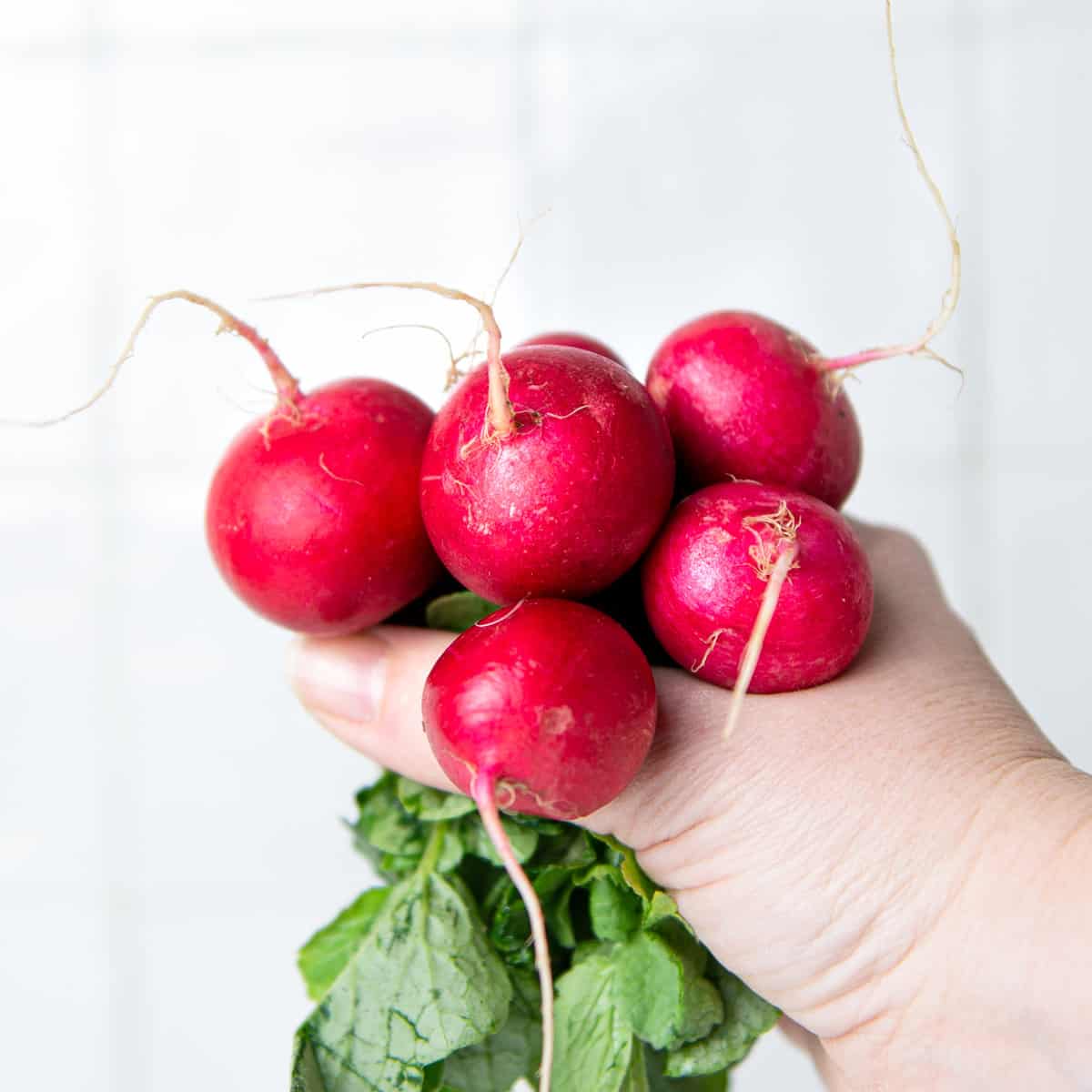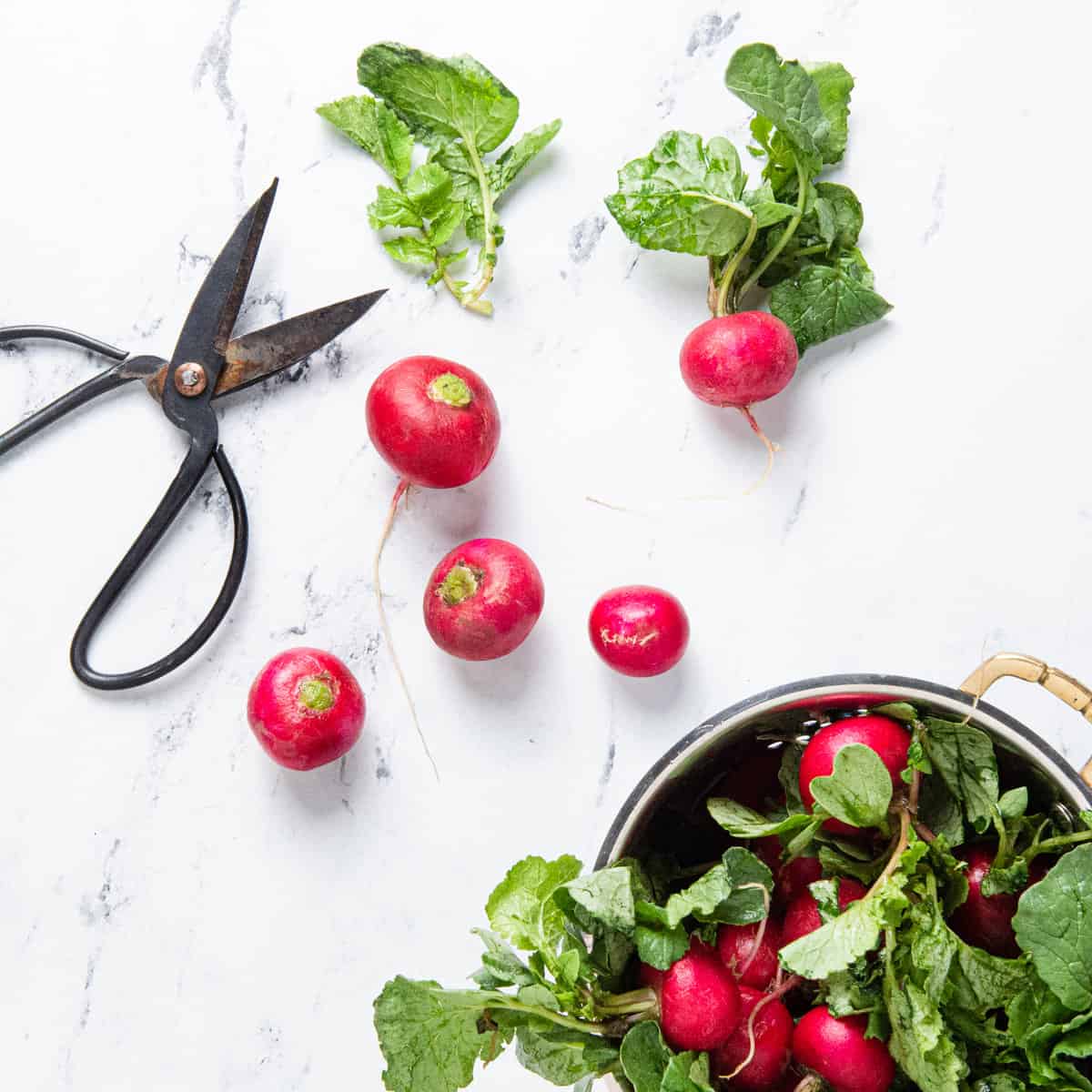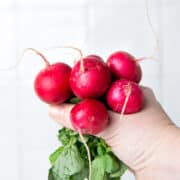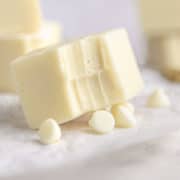Radishes are a crisp, peppery root vegetable that's popular in salad recipes. Knowing how to store radishes means you can keep them crunchy and fresh for as long as possible.

Jump to:
Because of their strong flavor, radishes are polarizing. People seem to either love them or hate them! Personally, I love their pungent, peppery, mustardy taste, and often add them to summer salads for a pop of color as well as the distinctive flavor they add.
You can find these vegetables at grocery stores or farmers' markets or even try to grow your own. Root vegetables aren't hard to grow, and because radishes are small, you can even grow them in a container if you're short on space. You might want to increase your canning jar or mason jar collection since hopefully, you'll get a healthy crop.
What are Radishes?
Radishes (Raphanus Sativus) are crunchy textured root vegetables in the mustard family. There are different types of radishes, including the little cherry-sized ones with white flesh and red skin, along with carrot-shaped daikon or mooli radishes, black radishes, or French Breakfast radishes which are long and thin with dark pink skin fading to white at the root.
Watermelon radishes have been popular lately because they're so pretty. This radish variety is only named that because they're reddish pink inside and have a greenish white skin like a watermelon. They taste like regular radishes, but if you want to make a gorgeous Insta-worthy salad, you might like to add these.
Radishes contain potassium, folic acid, magnesium, calcium, riboflavin, and Vitamin B6. So as well as giving a peppery crunch to your favorite salad recipes, they are good for you. This vegetable is in season between the spring and fall although you can find them year-round in grocery stores.
Ancient Egypt is where radishes are believed to have originated. The pharaohs would feed them to pyramid-building laborers. This vegetable made its first appearance in England around 1500 and then it made its way across the Atlantic where it's equally popular. Today you can find them all over the world, although some varieties are more popular in the West and others are better known in the West.
The flavor of radishes is largely determined by where they're grown. Hot temperatures make radishes spicy while cold temperatures make them sweet and mild. Regardless of the cultivar, every kind of radish prefers loose soil without stagnant water. Fresh radishes grow fast and don't require much care, so if you want to try some gardening, you shouldn't have any trouble growing your own.
What to Look for When Buying Radishes
Good radishes will be smooth, firm, and free from blemishes. At the grocery store, they should be in the refrigerated section. Soft radishes are likely to be spongey on the inside, so avoid those if you can. If they're a little soft, they will still be okay for cooking or using in soup recipes.
Larger radishes are naturally less crisp, so check the average-sized ones in the package. Also, if there are any greens left on the radishes, they should be bright and healthy-looking. Sometimes radishes have been trimmed of the greens and leaves, but they often come with the greens, which you can cook!

How to Store Radishes
If you don't store radishes the correct way, they'll turn mushy fast. That doesn't mean you need a root cellar. The following tips will be helpful if you love radishes as much as me and want them to stay fresh for longer.
- The first thing to do is wash, trim, slice, or cut radishes until you're ready to use them, although trimming down the green stems (if present) doesn't affect how long they'll keep.
- In a dark place, at room temperature, unwashed radishes should last for a couple of days. Put the leaves upwards in a bowl of water. Don't let the water reach the leaves. Change the cold water every day until the leaves droop and then either refrigerate or use them.
- If you want to keep them for longer, refrigerate them rather than keeping them on the kitchen counter. Again, don't wash or cut the radishes first.
- Using the above large bowl method, you can expect the radishes to last for 5 to 7 days, so it's a good method for short-term storage.
- If you want them to last even longer, trim off the radish tops and roots, then line a mason jar or airtight container with a damp paper towel, because radishes prefer high humidity, 95% to 100% in fact.
- Add the radishes and seal, after squeezing out as much air as you can. They should be fine for up to 2 weeks in the crisper drawer of the fridge if you change the paper towels when they dry out.
Another option is freezing and that's a great way to keep your radishes good long term, and a great idea if you have a lot of radishes to store. Since radishes are so easy to grow, you might find you have more of them than you know what to do with!
The best way is to remove the roots and leaves and rinse the radishes in cold water. Chop the radishes, boil them for a couple of minutes, and then plunge them into ice water. Dry them well and then arrange them in one layer on a baking sheet, cover them with plastic wrap, and freeze overnight. Transfer them into a freezer bag and use them within 6 months.
How to Tell if Radishes are Spoiled
Fresh radishes should be crisp, crunchy, and peppery. Rotten ones will be wrinkled, smell bad or feel squishy. Radishes turn black when rotting and then develop mold, so you should be able to tell by look, smell, and feel whether radishes are rotten or fresh. Remember they have a high water content so, if not stored properly, can rot fast.
Common Questions
Although these crunchy vegetables are best known as a salad addition, they are also good when cooked and can be served in a variety of different dishes. There are various ways to cook them including grilling, broiling, and pan-frying. Whichever cooking method you choose, cooked radishes are sweeter and less pungent than raw ones, so if you aren't so keen on the spicy taste, this might be a good way to serve them.
My favorite way to make them is thinly sliced and sautéed in garlic-infused olive oil. You can also add them to stews as a low-carb alternative to potatoes. If your radishes are a little beyond their prime, they're still ideal for cooking since they will get a little soft anyways.
Radishes sometimes come with the greens still attached and they're perfectly edible. If you choose to eat them, make sure you give them a good wash to get rid of any debris or dirt. You can either swish them in cold water or put them in a colander and run water over them.
Heat some oil in a pan and fry some minced garlic. Add the radish greens, grind in some salt and black pepper, and cook for a few minutes. The cooking time is similar to that of spinach, so it shouldn't take more than 3 or 4 minutes to cook them. When they're wilted and have softened, they're done. You can use any herbs, spices, and seasonings you want, and you'll find these greens pair with any kind of cuisine. They can be a side dish or a garnish.
Yes you can, which is good news because radishes are best when super-crunchy! Put whole radishes in a bowl of ice water for an hour. They will absorb some of the water which crisps them back up a bit.

Interesting Facts
- California and Florida grow more radishes than any other state.
- The heaviest radish ever grown weighed an astonishing 101 pounds 1.8 ounces.
- You can grow radishes all year round on your kitchen windowsill. Since it has a brief growing season, you should be able to pick and eat the radishes after just 3 or 4 months.
- Radishes were one of the first vegetables to be grown in space.
Now you know some different ways of storing radishes you can enjoy the health benefits, crunchy appeal, and distinctive flavor of this tasty vegetable.














